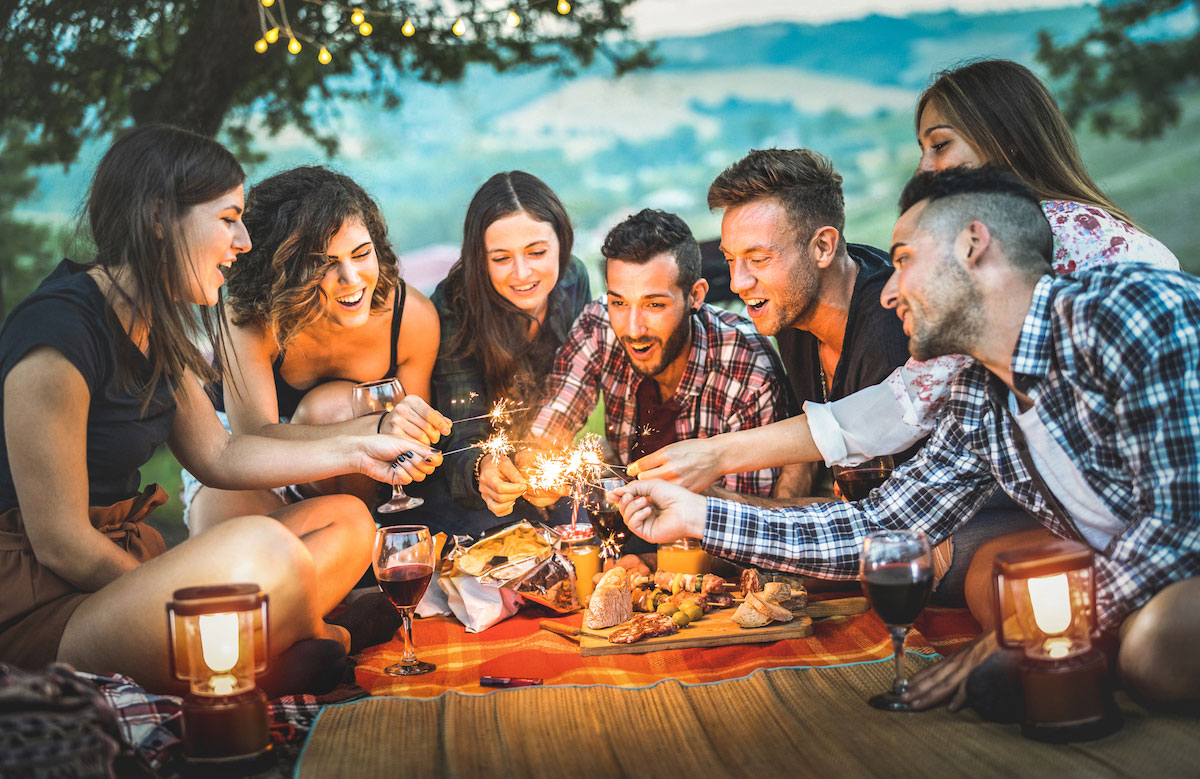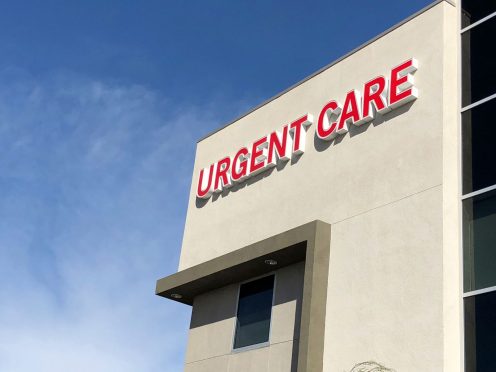If you’re not quite ready for summer, the Fourth of July will hit you on your head with it. Of course, we always think safety first, so here are some tips that should last the season. And if you do get a bump on the your head, a minor cut or burn, we’ll tell you where to go.
The Cookout
Here you go, grillmeisters:
- Always keep raw meat separate from produce and service ware.
- To significantly reduce the risk of cross contamination: purchase a raw-meat only cutting board, color-code so cookware used for raw meat is not used for other items, and immediately discard marinades used for raw meat.
- Do not use wooden utensils and bowls because the porous surface can hold on to potentially harmful bacteria.
- To ensure meat cooks evenly, preheat the grill and create two heat zones. A good tip is to position thicker portions of meat closer to the flame. Do not cook directly over the flame because that will result in a burnt exterior and undercooked interior.
- To determine doneness, let whole cuts of meat rest for three to five minutes, and then insert a food-grade thermometer in to the thickest portion. If the safe minimum temperature is not reached within 15 seconds of inserting the thermometer, put it back on the grill.
Safe Minimum Temperatures
Poultry, whole and ground: 165 degrees
Ground Meat (excluding poultry): 160
Steaks, roasts, and chops: 145
Fish: 145
Storage
- All refrigerated foods and raw meat should be kept at or below 40 degrees. Bacteria can begin to multiply when frozen and refrigerated foods are warmer than 40 degrees.
- Meat should be thawed in the refrigerator or under cool running water. Never unthaw meat on the counter.
- Keep cold food on ice beneath a tent or shaded area. Cover dishes and service ware to keep flies and other pests away and note when the food is put outside so you know if it is still safe to eat.
- Food is not safe to eat when it has been in the danger zone of 40-140 degrees for more than two hours (1 hour if the temperature is above 90 degrees). If unsure, the safest thing to do is throw it away.
Fireworks Safety
Follow these safety tips from the Consumer Product Safety Commission when using fireworks:
- Never allow young children to play with or ignite fireworks.
- Avoid buying fireworks that are packaged in brown paper because this is often a sign that the fireworks were made for professional displays and that they could pose a danger to consumers.
- Always have an adult supervise fireworks activities. Parents don’t realize that young children suffer injuries from sparklers. Sparklers burn at temperatures of about 2,000 degrees — hot enough to melt some metals.
- Never place any part of your body directly over a fireworks device when lighting the fuse. Back up to a safe distance immediately after lighting fireworks.
- Never try to relight or pick up fireworks that have not ignited fully.
- Never point or throw fireworks at another person.
- Keep a bucket of water or a garden hose handy in case of fire or other mishap.
- Light fireworks one at a time, then move back quickly.
- Never carry fireworks in a pocket or shoot them off in metal or glass containers.
- After fireworks complete their burning, douse the spent device with plenty of water from a bucket or hose before discarding it to prevent a trash fire.
- Make sure fireworks are legal in your area before buying or using them.
Sun Safety
Clouds diminish, but do not eliminate, damaging ultraviolet exposure. A good weather app lists the UV Index, the best indicator of the day’s risks. Make sure your daily weather forecast includes it.
The UV Index forecasts the amount of ultraviolet radiation, which damages skin, that will reach the earth’s surface when the sun is highest in the sky, around noon each day. Here’s what the index’s numbers mean and what precautions you should take, as provided by the U.S. Environmental Protection Agency:
0 to 2: Low
Cautions:
- Wear sunglasses on bright days.
- If you burn easily, cover up and use broad spectrum SPF 30+ sunscreen.
- Watch out for bright surfaces, like sand, water and snow, which reflect UV and increase exposure.
3 to 5: Moderate
Cautions:
- Stay in shade near midday when the sun is strongest.
- If outdoors, wear protective clothing, a wide-brimmed hat, and UV-blocking sunglasses.
- Generously apply broad spectrum SPF 30+ sunscreen every two hours, even on cloudy days, and after swimming or sweating.
- Watch out for bright surfaces, like sand, water and snow, which reflect UV and increase exposure.
6 to 7: High
Cautions:
- Protection against skin and eye damage is needed.
- Reduce time in the sun between 10 a.m. and 4 p.m.
- If outdoors, seek shade and wear protective clothing, a wide-brimmed hat, and UV-blocking sunglasses.
- Generously apply broad spectrum SPF 30+ sunscreen every 2 hours, even on cloudy days, and after swimming or sweating.
- Watch out for bright surfaces, like sand, water and snow, which reflect UV and increase exposure.
8 to 10: Very High
Cautions:
- Unprotected skin and eyes will be damaged and can burn quickly.
- Minimize sun exposure between 10 a.m. and 4 p.m.
- If outdoors, seek shade and wear protective clothing, a wide-brimmed hat, and UV-blocking sunglasses.
- Generously apply broad spectrum SPF 30+ sunscreen every 2 hours, even on cloudy days, and after swimming or sweating.
- Watch out for bright surfaces, like sand, water and snow, which reflect UV and increase exposure.
11 or more: Extreme
Cautions:
- Unprotected skin and eyes can burn in minutes.
- Try to avoid sun exposure between 10 a.m. and 4 p.m.
- If outdoors, seek shade and wear protective clothing, a wide-brimmed hat, and UV-blocking sunglasses.
- Generously apply broad spectrum SPF 30+ sunscreen every 2 hours, even on cloudy days, and after swimming or sweating.
- Watch out for bright surfaces, like sand, water and snow, which reflect UV and increase exposure.
The Shadow Knows
When you don’t have access to the UV Index, an easy way to gauge your UV exposure is to check your shadow.
- If it’s taller than you (usually in the early morning and late afternoon): Lower exposure.
- If it’s shorter than you (usually midday): High levels of UV radiation. Protect your skin and eyes and stay in the shade.
For information about skin cancer, visit the Hartford HealthCare Cancer Institute’s new Melanoma and Skin Cancer Center here.
If You Need Medical Help
The urgent care center, like Hartford HealthCare-GoHealth Urgent Care, is designed as a less-expensive alternative to emergency rooms for patients who need immediate care for conditions that are not life-threatening.
- Colds
- Flu
- Fever
- Asthma
- Allergies
- Emphysema
- Minor skin lacerations, cuts
- Burns
- Urinary tract infections
- Sports injuries, sprains and strains.
Hartford HealthCare-GoHealth Urgent Care centers will also provide lab services and X-rays for joint and bone injuries, using a portable machine that’s wheeled into the examination room. The X-ray machine is among the features that distinguish an urgent care center from a retail clinic, which are usually staffed by nurse practitioners and offer more basic services like flu shots, vaccinations and treatment of minor wounds, joint sprains, poison ivy and other skin conditions.
The urgent care centers do not treat:
- Major trauma
- Chest pain
- Difficulty breathing
- Stroke
- Head trauma
- Severe bleeding
- Vision loss
In any of these situations, dial 911 or visit a Hartford HealthCare emergency room immediately.
If you need care beyond the scope of the Hartford HealthCare-GoHealth Urgent Care center, whether a primary care or specialty care, your electronic records can be accessed by caregivers in the Hartford HealthCare network.
If you need to visit a nearby Hartford HealthCare Emergency Room, click here for wait times and more information.


